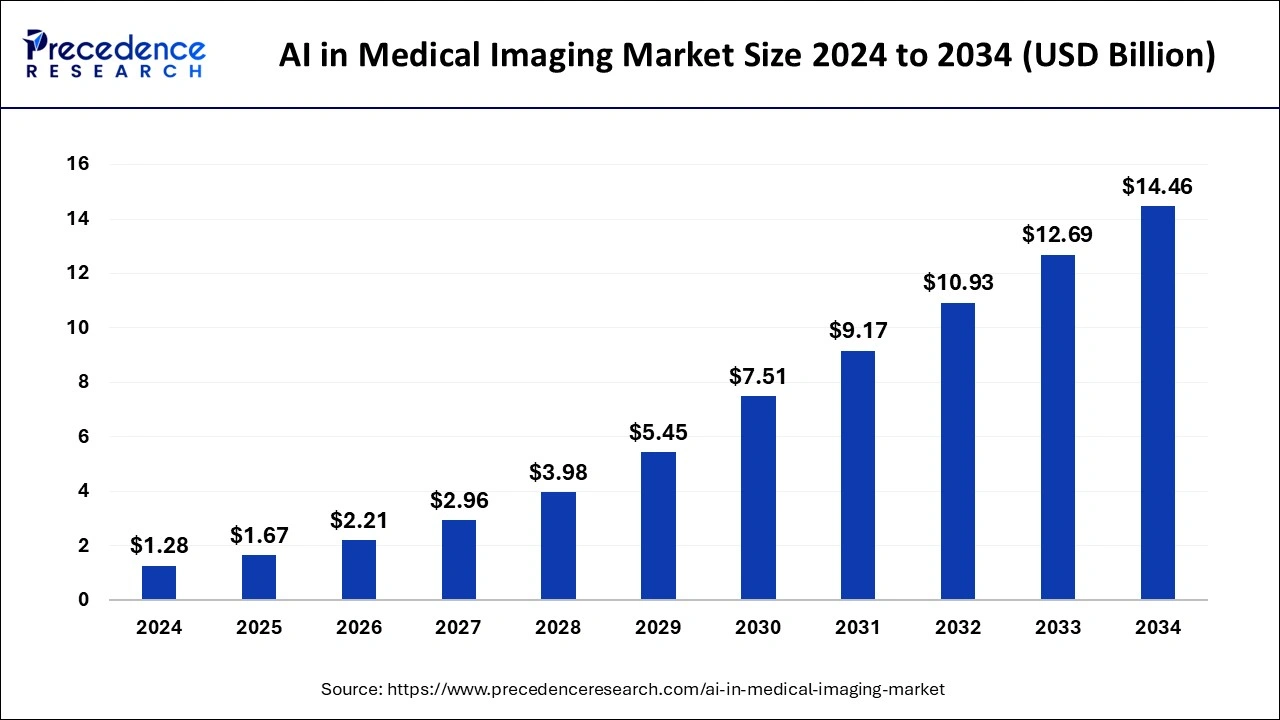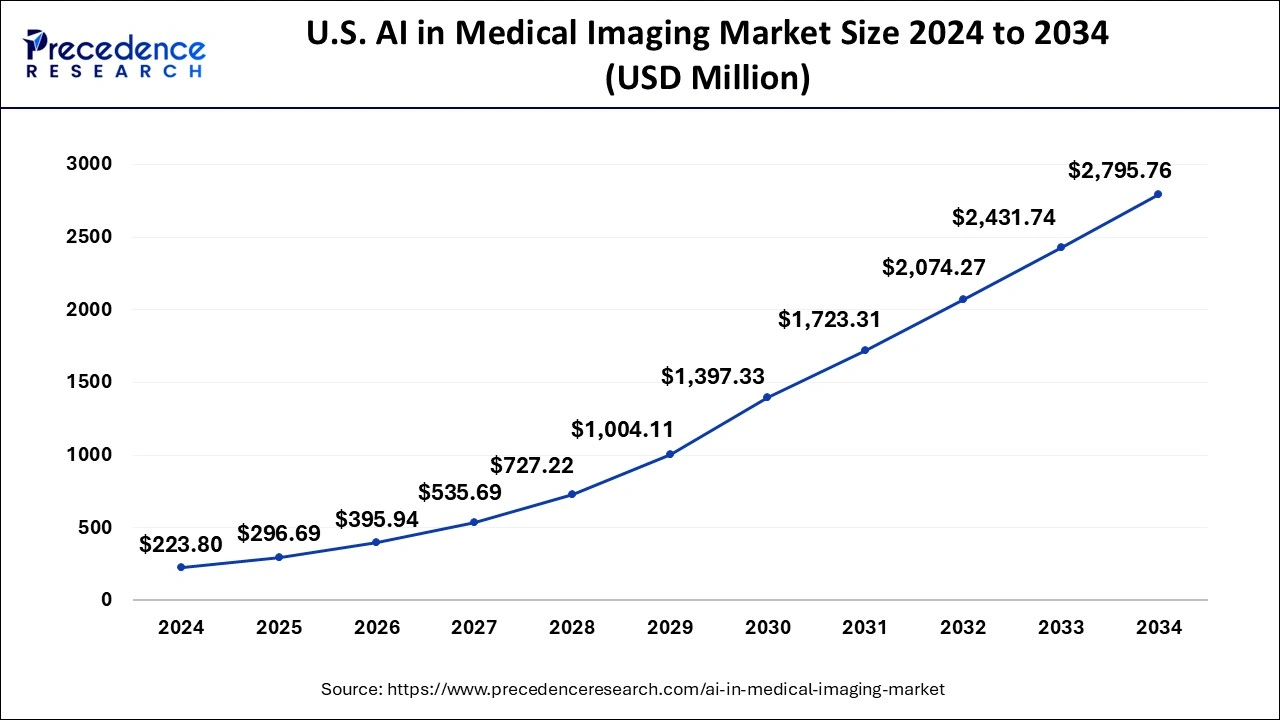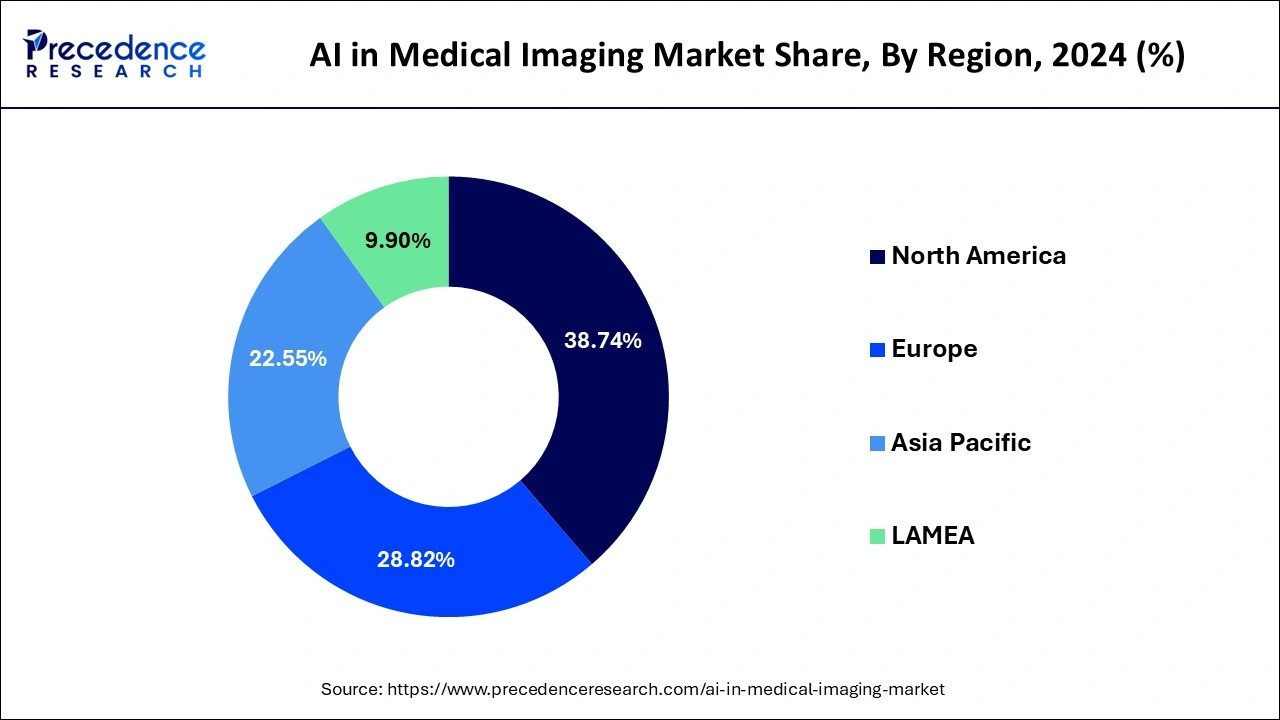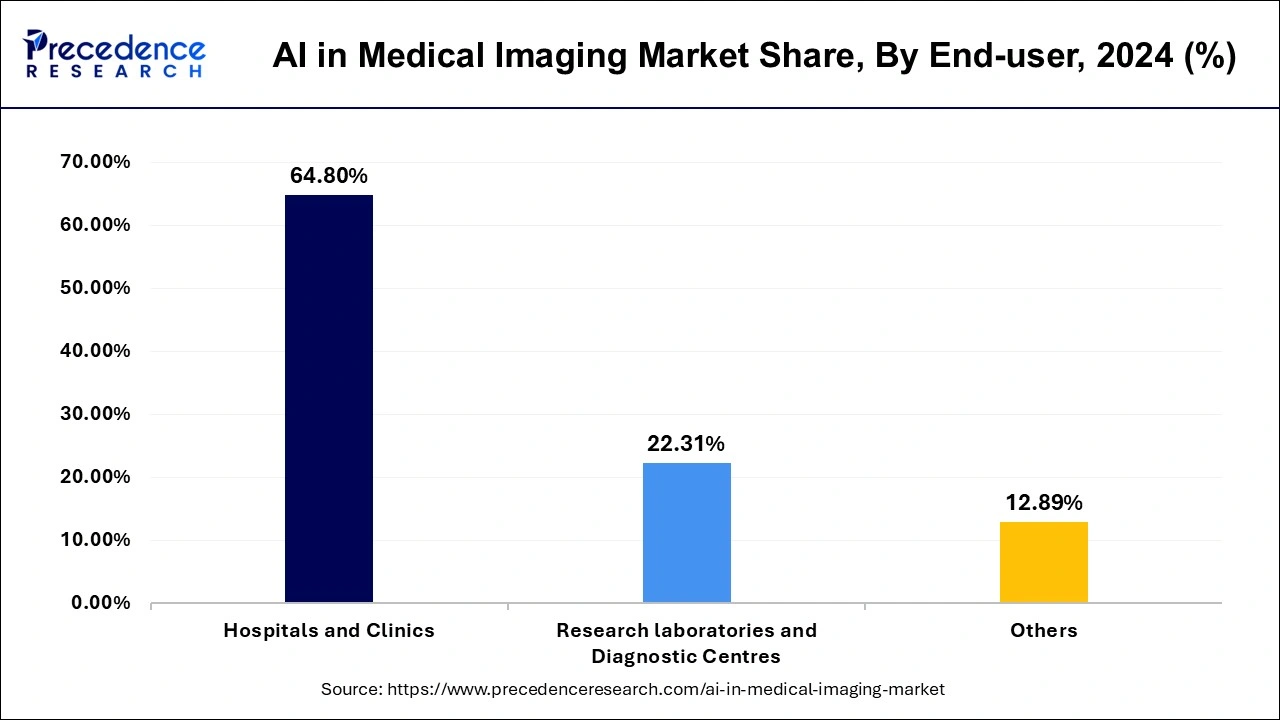List of Contents
AI in Medical Imaging Market Size and Forecast 2025 to 2034
The global AI in medical imaging market size was estimated at USD 1.28 billion in 2024 and is predicted to increase from USD 1.67 billion in 2025 to approximately USD 14.46 billion by 2034, expanding at a CAGR of 27.10% from 2025 to 2034. The diagnostic process known as medical imaging may be characterized as the generation of visual aids and picture representations of the human body, as well as the observation of the performance and functionality of the human organs. Artificial intelligence (AI) is changing how diagnoses and the whole procedure are carried out in the healthcare and medical imaging fields.

AI in Medical Imaging Market Key Takeaways
- North America has held the highest revenue share of over 38.74% in 2024.
- Asia Pacific is poised to grow at the fastest CAGR of 28.1% between 2025 and 2034.
- By application, the neurology segment has dominated the market with a revenue share of 21.07% in 2024.
- By image acquisition technology, the computed tomography segment has held revenue share of 31.09% in 2024.
- By end-use, the hospitals and clinics segment accounted highest revenue share of 64.80% in 2024.
- By offering, software/platforms segment has contributed 58.65% revenue share in 2024.
U.S. AI in Medical Imaging Market Size and Growth 2025 to 2034
The U.S. AI in medical imaging market size was valued at USD 223.80 million in 2024 and is expected to reach USD 2,795.76 million by 2034, growing at a CAGR of 28.30% from 2025 to 2034.

Due to their highly developed healthcare systems and high levels of disposable wealth, North America and Europe dominate AI in the medical imaging industry. The need for artificial intelligence in medical imaging has also been spurred by the existence of important players and supportive governmental legislation.

Asia Pacific is the fastest growing market for the AI in medical imaging market with a significant CAGR during the forecast period, driven by increasing healthcare needs, technological progress, and supportive government policies. Nations like India, China, and Australia are leading the way, employing AI to improve diagnostic precision and workflow efficiency. In India, a rise in health-tech startups and government-supported digital health initiatives are promoting the adoption of AI in diagnostics. China's implementation of AI technologies such as DeepSeek in major hospitals is revolutionizing clinical decision-making. Australia's use of AI in its public radiology services showcases the region's dedication to utilizing AI for better healthcare results.
India
India is swiftly adopting AI in medical imaging, stimulated by a thriving health-tech landscape and government projects like the Ayushman Bharat Digital Mission. Startups including Qure.ai and Niramai are leading advancements in AI-based diagnostic tools, improving early disease identification. Partnerships between public institutions and private companies are fostering innovation, while the integration of AI within hospitals and diagnostic facilities is enhancing accuracy and accessibility in healthcare throughout the nation.
Europe is observed to grow at a considerable growth rate in the upcoming period, bolstered by strong healthcare systems, regulatory support, and collaborative research efforts. Countries such as Germany, the UK, and Spain are pioneers in the adoption of AI to improve diagnostic methods. Collaborations between healthcare providers and technology firms in Germany are advancing AI uses in radiology. The National Health Service in the UK is implementing AI solutions to boost diagnostic accuracy and efficiency. Investments in AI research facilities in Spain are driving innovation, positioning Europe as a significant player in the global AI medical imaging arena.
Germany
Germany leads the way in integrating AI within medical imaging, focusing on improving diagnostic accuracy and operational efficiency. Partnerships between healthcare organizations and tech companies are propelling the development of AI applications in radiology. The use of AI tools for early detection of diseases and personalized treatment approaches is enhancing patient outcomes. Germany's dedication to innovation and quality healthcare solidifies its position as a frontrunner in the field of AI medical imaging.
AI in Medical Imaging Market Growth Factors
One of the most promising areas of health and medical innovation is the use of artificial intelligence (AI) in medical imaging. Medical imaging uses AI in a variety of ways, including image capture, processing for assisted reporting, planning for follow-up visits, data storage, data mining, and more. AI has demonstrated impressive sensitivity and precision in the categorization of imaging abnormalities in recent years, and it guarantees to enhance tissue-based detection and characterization. A branch of artificial intelligence called machine learning (ML) uses computational models and algorithms that mimic the structure of the brain's organic neural networks. Layers of linked nodes make up the architecture of neural networks. Each network node weights and summarizes the input data before sending them to the activation function.
The diagnostic process was changed by the use of AI in healthcare and medical imaging, which stimulated the growth of the market for AI in medical imaging on a global scale. Medical practitioners are assisted by artificial intelligence in the execution of the picture acquisition process and in the analysis of these pictures for the diagnosis and personalized care of each patient. AI has been utilized by researchers to objectively evaluate radiographic properties and automatically identify difficult patterns in imaging data. In radiation oncology, Artificial Intelligence has been used to enhance many distinctive image modalities which are used at various stages of the therapy. One of the most well-liked study subjects in medical imaging nowadays is radiation omics, which involves the high-throughput extraction of a significant number of picture attributes from radiation images.
Additionally, AI plays a crucial role in the analysis of a large volume of medical photos, which reveals illness signs that are otherwise missed. As a result, it is anticipated that the market for AI in medical imaging will expand during the next years. Scientists have significantly advanced the effort to combat COVID-19; new study discoveries, such as analytical reports as well as publications from both university and corporate researchers, are emerging every day. A growing number of researchers are turning to artificial intelligence (AI) to detect and forecast diseases in the context of medical imaging studies. AI-based image analysis algorithms offer more accurate, effective, quick, stable, and reproducible illness information than conventional image processing techniques. The basis of AI-based COVID-19 diagnosis processes is therefore image analysis, image segmentation of infected lung regions, and analytics for clinical evaluation. During the anticipated timeframe, these AI-based methods have shown great commercialization potential for AI in the medical imaging sector.
- Artificial intelligence is making its way into many everyday applications, from voice recognition and driver assistance systems in automobiles to intelligent chatbots at help desks. When artificial intelligence is used to correctly identify photos, amazing results are obtained.
- Medical imaging plays a big role in healthcare and offers precise illness diagnosis and management. Technology and digital data have revolutionized the photographic industry. As a result, during the past several years, the adoption of AI-based solutions in the healthcare industry has expanded.
- The market for AI in medical imaging is supported by the use of AI in imaging analysis to increase accuracy, speed up interpretation, and decrease repetition for radiologists.
- Growth in the usage of AI technologies for medical purposes has resulted from increased knowledge of the advantages given by AI technologies and their numerous applications in the healthcare sector, helping the market for AI in medical imaging.
- A number of hospitals and healthcare organizations have embraced artificial intelligence as a more appealing option for therapeutic applications. Leading businesses are making significant investments in AI technology solutions for medical imaging. Researchers and businesses are working together to develop efficient AI-based systems.
- Developed nations have been investing in cutting-edge, cost-effective healthcare systems for their citizens as a result of population issues, which has fueled the market for AI in medical imaging. Such tactics encourage market participants to make investments in the healthcare industry and provide cutting-edge solutions to clients, increasing their position in AI in the medical imaging market.
Market Scope
| Report Coverage | Details |
| Market Size in 2024 | USD 1.28 Billion |
| Market Size by 2034 | USD 14.46 Billion |
| Growth Rate from 2025 to 2034 | CAGR of 27.10% |
| Base Year | 2024 |
| Forecast Period | 2025 to 2034 |
| Segments Covered | AI Technology, Solution, Modality, Application, End Use, and Regions |
| Regions Covered | North America, Europe, Asia-Pacific, Latin America, and Middle East & Africa |
Market Dynamics
Key Market Drivers
AI-based diagnostic imaging improves care models in the healthcare sector
- The introduction of cutting-edge AI tools and technology is expected to play a significant role in the near-term transformation of the radiology and healthcare sectors. The present market for AI in medical imaging is predicted to offer a wide range of opportunities for businesses with more use of AI in the medical sector, notably in radiology.
- Expanding the gap between the increasing number of radiologists available and the number of scans that can interpret data is a significant element that will probably accelerate the adoption of AI in medical imaging.
- Due to the increased workload and pressure to expedite the process of data interpretation, mistakes significantly increased. This in turn is opening up opportunities for market presence expansion for players in the AI-enabled diagnostic imaging market.
Key Market Challenges
Medical professionals' reluctance to utilize AI-based technology
- Healthcare professionals may now help patients through cutting-edge treatment modalities thanks to the extensive rise of digital health. With the use of AI technology, doctors can better diagnose and treat patients. However, it has been noted that doctors are reluctant to adopt new technology. For instance, doctors mistakenly believe that AI would eventually supplant them in the medical field. As per doctors' and radiologists' beliefs, technology cannot entirely rule out the existence of a doctor because abilities like empathy and persuasion are considered to be human traits. A further worry is that patients may turn away from critical in-person treatments due to their excessive propensity for these technologies, which might strain long-term doctor-patient relationships. Many medical practitioners are skeptical about the accuracy with which AI can diagnose patient diseases. It is difficult to persuade providers that AI-based solutions are affordable, secure, and effective solutions that provide doctors with convenience and better patient care. Healthcare providers are, however, more open to the potential advantages of AI-based solutions and the variety of fields they may be used in. Therefore, it's possible that in the years to come, physicians and radiologists may be increasingly receptive to AI-based technology in healthcare.
Key Market Opportunities
Emerging economies display significant potential
- Developing nations are concentrating on pooling their investments in AI, which will enable businesses to use AI with medical imaging to increase their revenue share. For instance, China wants to lead the world in artificial intelligence by 2030. The strategy calls for significant government financing and investments to accelerate the use of AI technologies in businesses. Additionally, it is projected that companies in the market for AI in medical imaging would benefit from the growing patient populations in nations like India, China, and Brazil. By 2031, the market for artificial intelligence in medical imaging is anticipated to be worth US$20 billion, growing at a CAGR of 36%.
Image Acquisition TechnologyInsights
The x-ray segment held the largest share in AI in medical imaging market. Artificial intelligence (AI) algorithms have the ability to identify minute patterns or abnormalities in X-ray pictures that human radiologists can miss, increasing diagnostic precision and lowering the possibility of a false positive. The time needed for diagnosis can be decreased by using AI to automate the process of X-ray picture analysis. This can be very important in emergency cases where patient outcomes depend on prompt diagnosis. Rather than taking the place of radiologists, AI is a tool to enhance their talents. AI-generated insights can help radiologists make better decisions and treat patients more effectively. Precision medicine is advanced by AI in medical imaging, which goes beyond diagnosis to incorporate predictive analytics, customized treatment planning, and outcome prediction.
The computed tomography segment is expected to be the fastest growing market during the forecast period. Among the major components of the AI in medical imaging market is computed tomography (CT). Artificial intelligence (AI) technologies have improved the efficiency, accuracy, and interpretation of CT scans in the field of medical imaging. AI algorithms can improve CT scan image reconstruction methods, minimizing artifacts and enhancing image quality. Better visuals for diagnosis result from this. Radiologists can use AI to help them identify and describe anomalies, tumors, or lesions on CT scans. It can support early cancer diagnosis and therapy planning, among other things. AI can automate repetitive processes in CT imaging workflows, including data administration, report production, and image processing, which boosts productivity and efficiency in radiology departments.
End-user Insights
The hospitals and clinics segment held the largest share in AI in medical imaging market. AI technology is being incorporated by numerous hospitals and healthcare systems into their medical imaging departments in an effort to improve patient care, workflow efficiency, and diagnosis accuracy. Businesses that manufacture medical imaging equipment have begun adding AI features to their products or creating AI-powered alternatives to enhance their selection. A lot of IT businesses are concentrating on creating AI software and algorithms specifically for medical image analysis. A few of these businesses are becoming more well-known in the industry and forming alliances with healthcare providers. To enhance healthcare results and cut costs, government health organizations across the globe are now investing in AI technologies for medical imaging. These organizations might oversee regulations, give funding for research studies, or assist with pilot projects.

The research laboratories and diagnostic centers segment is expected to be the fastest growing market during the forecast period. Google Health has been actively contributing to the AI medical imaging application development process. They have research teams that are focused on applying machine learning algorithms to diagnose diseases and analyze images. Microsoft has made investments in medical imaging and other AI-related technologies. They work together with academic institutions and healthcare organizations to provide AI-driven picture analysis and diagnosis solutions. Another significant participant in the medical imaging market is Siemens Healthineers. To enhance the functionality of their imaging equipment and allow for more precise diagnosis, they have been investing in AI research and development. An increasing number of firms are focused on medical imaging enabled by AI. These firms work closely with academic institutions and healthcare organizations to create and market cutting-edge artificial intelligence technologies.
AI in Medical Imaging Market Revenue (USD Million), By End User, 2022-2024
| End User | 2022 | 2023 | 2024 |
| Hospitals and Clinics | 489.13 | 633.10 | 826.76 |
| Research Laboratories and Diagnostic Centres | 171.18 | 219.75 | 284.61 |
| Others | 102.53 | 129.31 | 164.49 |
Application Insights
The neurology segment held the largest share of AI in medical imaging market. Artificial intelligence (AI) algorithms are capable of analyzing medical images from CT (Computerized Tomography) or MRI (Magnetic Resonance Imaging) scans to identify anomalies in the brain, including tumors, lesions, or indications of neurodegenerative disorders like Parkinson's or Alzheimer's. Accurate segmentation of brain structures and regions of interest in medical pictures is made possible by AI approaches. For tasks like radiation therapy, surgical planning, or monitoring the course of a disease over time, this division is essential. Large datasets have taught AI algorithms to recognize patterns and connections in medical images that might not be immediately obvious to human observers. AI can help doctors with individualized patient care by using these patterns to predict neurological condition risk factors, treatment response, and illness progression.
The breast (Mammography) segment is expected to witness a notable rate of growth during the forecast period. Artificial intelligence (AI) in medical imaging, especially mammography, has great potential to improve breast cancer early detection and improve diagnostic accuracy. Although mammography is an essential technique for screening for breast cancer, it occasionally produces false positive results or misses subtle abnormalities. Deep learning algorithms that have been trained on big data sets of mammogram pictures are commonly used in mammography-specific AI products in the medical imaging market. These algorithms exhibit great sensitivity and specificity in identifying patterns suggestive of breast cancer, such as microcalcifications, masses, or architectural abnormalities. AI workflow integration for mammography has the potential to expedite report turnaround times, simplify interpretation procedures, and enhance patient care in the long run.
AI in Medical Imaging Market Revenue (USD Million), By Application, 2022-2024
| By Application | 2022 | 2023 | 2024 |
| Digital Pathology | 96.04 | 123.27 | 159.64 |
| Oncology | 85.29 | 110.15 | 143.53 |
| Cardiovascular | 82.69 | 106.22 | 137.67 |
| Neurology | 158.98 | 205.79 | 268.76 |
| Lungs (Respiratory System) | 64.23 | 83.12 | 108.51 |
| Breast (Mammography) | 139.37 | 180.94 | 236.99 |
| Liver (GI) | 54.85 | 70.36 | 91.06 |
| Oral Diagnostics | 31.73 | 40.44 | 51.99 |
| Others (Pediatric ailments, Orthopedics, etc.) | 49.66 | 61.88 | 77.70 |
AI in Medical Imaging Market Companies
- Agfa-Gevaert Group
- Ada Health
- Enlitic Inc
- CELLMATIQ GMBH
- GENERAL ELECTRIC COMPANY
- IBM
- NVIDIA CORPORATION
- MICROSOFT
- KONINKLIJKE PHILIPS N.V.
- SIEMENS
Recent Developments
- In May 2025, The National Health Service of the UK has embraced AI-powered 3D heart scanning technology in 56 hospitals, significantly decreasing the necessity for invasive procedures and yielding considerable cost savings. This effort improves diagnostic accuracy for coronary heart disease and demonstrates effective AI integration in public health services.
- In February 2025, South Australian Medical Imaging has incorporated AI from Annalise.ai across its radiology services, aiding in the interpretation of chest X-rays. This deployment signifies a major step forward in public health, enhancing both diagnostic accuracy and efficiency in medical imaging.
- In March 2025, A multi-center study in India has rolled out an AI system for interpreting chest X-rays, achieving high levels of precision and recall in identifying various pathologies. Implemented in 17 healthcare facilities, this AI model streamlines diagnostic workflows and aims to close gaps in underserved regions.
- The Avicenna. The FDA accepted AI's application for CINA-LVO, CINA-ICH, and neurovascular crises, according to a June 2021 report from the Nuance AI marketplace. This is the largest and first gateway of its sort in the United States, providing a single point of entry to a broad range of AI diagnostic models within the radiology reporting platform.
- In June 2021, VUNO Inc., a South Korean AI business, announced a strategic partnership with Samsung Electronics for the incorporation of the AI-powered mobile digital X-ray system VUNO Med-Chest X-ray within the GM85. This partnership is projected to bring VUNO closer to the expansion of AI applications that are market-ready due to its access to the global market.
Segment Covered in the Report
By Solution
- Software Tools/ Platform
- Services
- Integration
- Deployment
By Image Acquisition Technology
- X-Ray
- Computed Tomography
- Magnetic Resonance Imaging
- Ultrasound Imaging
- Molecular Imaging
By Application
- Digital Pathology
- Oncology
- Cardiovascular
- Neurology
- Lung (Respiratory System)
- Breast (Mammography)
- Liver (GI)
- Oral Diagnostics
- Other
By End Use
- Hospitals and Clinics
- Research Laboratories and Diagnostic Centers
- Others (Ambulatory Surgical Centres, Intensive care at home, etc.)
By Geography
- North America
- Europe
- Asia-Pacific
- Latin America
- Middle East & Africa (MEA)
For inquiries regarding discounts, bulk purchases, or customization requests, please contact us at sales@precedenceresearch.com
Frequently Asked Questions
Ask For Sample
No cookie-cutter, only authentic analysis – take the 1st step to become a Precedence Research client